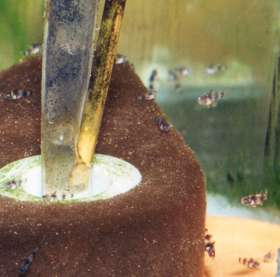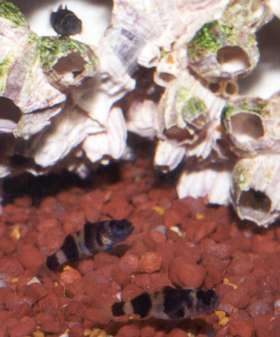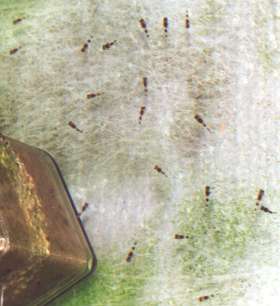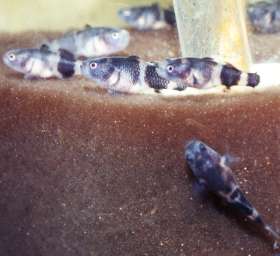| (Bee Keeping cont'd.) hopping), and they were an almost uniform pale yellow/gold colour. Only by looking closely could I see traces of the dark vertical stripes. I wondered if our change in treatment had made them sick. They were acting a bit demented. I settled down to watch and, since they were darting in and out of the caves in their barnacle, I thought, maybe not demented, maybe, finally, spawning activity.
They were indeed the males. The females were obvious. They hadn't changed colour at all. If anything their stripes seemed even darker and they were very rotund. The antics of the males appeared to be working because some of the females were definitely hanging around the cave entrances. Once in awhile one would pop inside for a moment. Apparently, at least one female agreed to stay a bit longer and lay some eggs because, a few days later, a patch of eggs could be seen suspended like little sacks from the top and sides of one of the caves, and the male, (now back to normal colour), was in there on guard. He came out and looked menacing when any other fish came too close. Perhaps the eggs had been there longer than I realized because, 4 days later many little transparent |
slivers with, except for their eyes, just one spot visible in the middle of their bodies, were swimming around in the tank. Baby (enlarged) We quickly prepared a 5 gallon tank with a box and a sponge filter and partially filled it with water syphoned from the parent's tank -- along with as many of the hatchlings as I could suck into the syphon hose. A small fine-meshed net was used to catch a bunch more and the rest were left to their fate. The rearing tank was gradually topped up with fresh water at about the same salinity to avoid any shock to the babies. A rough count showed that I had captured at least 80 fry and that was plenty. Those that remained in the parent's tank lasted for 2 or 3 days and then gradually disappeared.
We fed the fry paramecium, vinegar eels and, sparingly, liquid fry food for a few days and then began adding a little newly hatched brine shrimp nauplii. When the inevitable pink bellies appeared we continued with vinegar eels and shrimp nauplii only. The tank was kept very clean with partial water changes being done every day. Growth was fairly rapid. In a couple of weeks they began showing dark stripes and fairly |
soon they proved that their ventrals were fused because they began sticking to surfaces more and swimming freely less. I had never thought of duckweed as lethal but we lost several babies because they appeared to get stuck to the duckweed roots and were somehow unable to let go. I guess they starved to death. I removed all remaining bits of duckweed. Looking more like their parents By November the babies were small, perfect replicas of their parents and we even took a bag to Brampton's auction. I guess the idea of brackish water must have scared all those cichlid types because the auctioneer had to work hard to get any bid at all.
Does this mean that Bumblebee Gobies are worthless? We don't think so. It means that, around here anyway, you won't get rich by breeding them but the satisfaction of spawning and rearing a tankful of these little charmers is a fine reward in itself.
|


